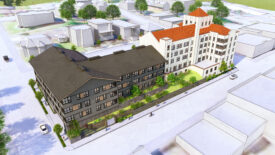More homebuilding options are legal beginning August 1, but what’s likely to actually get built?
Contacts:
Michael Andersen, Sightline Institute, senior researcher, michael@sightline.org, 503.333.7824
Steph Routh, Sightline Institute, strategic communications manager, steph@sightline.org, 971.506.8385
FOR IMMEDIATE RELEASE (July 30, 2021)
PORTLAND – As of this Sunday, Oregon’s largest city is also the largest in the United States where it’s legal on almost any residential lot to live in a duplex, triplex, fourplex, mixed-income sixplex, large group co-living home, double ADU or backyard home on wheels.
A series of major zoning reforms approved over the last 12 months takes effect in the city Aug. 1.
Sightline Institute, the Pacific Northwest’s sustainability think tank, wanted to know: Of all these new options, which is actually likely to get built? And for those that would get built, how much rent would be needed for them to exist?
Using a sample 5,000 square foot lot in Portland’s Montavilla neighborhood, Sightline used current land, construction and capital costs to answer these questions. The main finding: The only options that are likely to be widely viable at Portland’s current rents are those that don’t require demolition of an existing home.
“These figures suggest that for better or worse, re-legalizing the ‘missing middle’ of the housing market will likely have a very gradual effect on cities,” said Sightline senior researcher Michael Andersen. “On almost all lots here in Portland, the only infill projects that make economic sense are those that create new homes without demolishing existing structures, like double ADUs in the backyard. But when a structure does reach the end of its natural life, these numbers suggest it’ll now probably be replaced by a triplex or fourplex rather than being flipped or demolished for a McMansion.”
According to Sightline’s estimates of current construction, capital and operating costs, property owners could construct a double ADU on lots that have room and in neighborhoods where a newly built 800-square-foot two-bedroom home would rent for at least $1,760 per month.
“If 200 such homes get built next year, that’s 200 Portland households that won’t be forced to contribute to rising rents by competing with every other Portlander for existing homes,” said Andersen. “And potentially 200 households at the other end of the housing chain who won’t be displaced completely. Cities bracing for potential climate-related migration are probably going to want every one of these they can get.”
Sightline’s analysis also estimated the rent required to finance remodeling a larger house into a seven-bedroom group home—also a newly legal option. Those bedrooms could rent for $919 per month. And the think tank looked at another option allowed by Portland’s “Shelter to Housing Continuum” project focused on very-low cost dwelling options: the utility-connected backyard home on wheels. With rent of no less than $464 per month, a homeowner could finance the purchase of a new $50,000 weatherized RV trailer with kitchenette, bathroom, A/C, and dedicated plumbing and electric lines on a backyard gravel pad.
An illustration by of legal living options in Portland can be viewed here, and the building cost detail accessed here. Any use of either asset must be properly attributed and, if online, linked. Use of Sightline-produced graphics is permitted, with proper attribution and without alteration.
ABOUT SIGHTLINE INSTITUTE
Sightline Institute is a think tank providing leading original analysis of energy, economic, and environmental policy in the Pacific Northwest and beyond.






